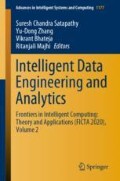Abstract
The abnormalities in the brain are frequently examined with signal/image supported methodologies. Image-based procedures will disclose more information concerning the functioning of brain contrast to signal assisted techniques. In this study, the examination of the Flair modality brain MRI is considered for testing. Compared to supplementary modalities, Flair MRI (FMRI) suggests improved visibility of the infected brain section; hence an automated procedure can be easily implemented for FMRI. This work implements an established automation procedure called the Marker Controlled Watershed Mining (MCWS) to extract the infected section from the chosen brain FMRI slice. The investigational exploration is implemented with the BRATS2015 database, and finally, the superiority of MCWS mining is confirmed by computing the picture similarity measures (PSM). This work confirms that MCWS practice offers an average PSM of >92% for the considered FMRIs.
Access this chapter
Tax calculation will be finalised at checkout
Purchases are for personal use only
References
Bhateja, V., Nigam, M., Bhadauria, A.S., Arya, A., Yu-Dong Zhang, Y-D.: Human visual system based optimized mathematical morphology approach for enhancement of brain MR images. J. Ambient. Intell. Humaniz. Comput. 1–9 (2019). https://doi.org/10.1007/s12652-019-01386-z
Satapathy, S.C., El-Maleh, A., Bhateja, V.: Intelligent computing in multidisciplinary engineering applications. Arab. J. Sci. Eng. 43(8), 3861–3862 (2018)
Wang, R., Wang, G.: Web text categorization based on statistical merging algorithm in big data environment. Int. J. Ambient Comput. Intell. (IJACI) 10(3), 17–32 (2019). https://doi.org/10.4018/IJACI.2019070102
Ali, et al.: Adam deep learning with SOM for human sentiment classification. Int. J. Ambient Comput. Intell. (IJACI) 10(3), 92–116 (2019). https://doi.org/10.4018/IJACI.2019070106
Fernandes, S.L., et al.: A reliable framework for accurate brain image examination and treatment planning based on early diagnosis support for clinicians. Neural Comput. Appl. 1–12 (2019). https://doi.org/10.1007/s00521-019-04369-5
Dey, N., et al.: Social-group-optimization based tumor evaluation tool for clinical brain MRI of flair/diffusion-weighted modality. Biocybernetics Biomed. Eng. 39(3), 843–856 (2019). https://doi.org/10.1016/j.bbe.2019.07.005
Acharya, U.R., et al.: Automated detection of Alzheimer’s disease using brain MRI images—a study with various feature extraction techniques. J. Med. Syst. 43, 302 (2019). https://doi.org/10.1007/s10916-019-1428-9
Jahmunah, V., et al.: Automated detection of schizophrenia using nonlinear signal processing methods. Artif. Intell. Med. 100, 101698 (2019). https://doi.org/10.1016/j.artmed.2019.07.006
Rajinikanth, V., Dey, N., Satapathy, S.C., Ashour, A.S.: An approach to examine magnetic resonance angiography based on Tsallis entropy and deformable snake model. Futur. Gener. Comput. Syst. 85, 160–172 (2018). https://doi.org/10.1016/j.future.2018.03.025
Raja, N.S.M., Fernandes, S.L., Dey, N., Satapathy, S.C., Rajinikanth, V.: Contrast enhanced medical MRI evaluation using Tsallis entropy and region growing segmentation. J. Ambient. Intell. Humaniz. Comput. 1–12 (2018). https://doi.org/10.1007/s12652-018-0854-8
Menze, et al.: The multimodal brain tumor image segmentation benchmark (BRATS). IEEE Trans. Med. Imaging 34(10), 1993–2024 (2015). https://doi.org/10.1109/TMI.2014.2377694
Yushkevich, P.A., Gao, Y., Gerig, G.: ITK-SNAP: An interactive tool for semi-automatic segmentation of multi-modality biomedical images. In: 38th Annual International Conference of the IEEE Engineering in Medicine and Biology Society (EMBC), IEEE, pp. 3342–3345 (2016). https://doi.org/10.1109/embc.2016.7591443
Rajinikanth, V., Satapathy, S.C.: Segmentation of ischemic stroke lesion in brain MRI based on social group optimization and Fuzzy-Tsallis entropy. Arab. J. Sci. Eng. 43(8), 4365–4378 (2018). https://doi.org/10.1007/s13369-017-3053-6
Satapathy, S.C., Rajinikanth, V.: Jaya algorithm guided procedure to segment tumor from brain MRI. J. Optim. 2018, 12 (2018). https://doi.org/10.1155/2018/3738049
Srivastava, A., Bhateja, V., Moin, A.: Combination of PCA and contourlets for multispectral image fusion. Adv. Intell. Syst. Comput. 469, 577–585 (2017). https://doi.org/10.1007/978-981-10-1678-3_55
Lakshmi, B., Parthasarathy, S.: Human action recognition using median background and max pool convolution with nearest neighbor. Int. J. Ambient Comput. Intell. (IJACI) 10(2), 34–47 (2019). https://doi.org/10.4018/IJACI.2019040103
Roerdink, J.B.T.M., Meijster, A.: The watershed transform: definitions, algorithms and parallelization strategies, Fundam. Informaticae 41(1, 2), 187–228 (2000). https://doi.org/10.3233/fi-2000-411207
Fernandes, S.L., Rajinikanth, V., Kadry, S.: A hybrid framework to evaluate breast abnormality using infrared thermal images. IEEE Consum. Electron. Mag. 8(5), 31–36 (2019). https://doi.org/10.1109/MCE.2019.2923926
Bhandary, A., et al.: Deep-learning framework to detect lung abnormality–a study with chest X-Ray and lung CT scan images. Pattern Recogn. Lett. (2019). https://doi.org/10.1016/j.patrec.2019.11.013
Dey, N., Rajinikanth, V., Ashour, A.S., Tavares, J.M.R.S.: Social group optimization supported segmentation and evaluation of skin melanoma images. Symmetry 10(2), 51 (2018). https://doi.org/10.3390/sym10020051
Rajinikanth, V., Fernandes, S.L., Bhushan, B., Sunder, N.R.: Segmentation and analysis of brain tumor using Tsallis entropy and regularised level set. Lect. Notes Electr. Eng. 434, 313–321 (2018)
Nair, M.V., et al.: Investigation of breast melanoma using hybrid image-processing-tool. In: International Conference on Recent Trends in Advance Computing (ICRTAC), IEEE, pp. 174–179 (2018). https://doi.org/10.1109/ICRTAC.2018.8679193
Author information
Authors and Affiliations
Corresponding author
Editor information
Editors and Affiliations
Rights and permissions
Copyright information
© 2021 The Editor(s) (if applicable) and The Author(s), under exclusive license to Springer Nature Singapore Pte Ltd.
About this paper
Cite this paper
Hariharan, D., Hemachandar, S., Sri Madhava Raja, N., Lin, H., Sundaravadivu, K. (2021). Inspection of 2D Brain MRI Slice Using Watershed Algorithm. In: Satapathy, S., Zhang, YD., Bhateja, V., Majhi, R. (eds) Intelligent Data Engineering and Analytics. Advances in Intelligent Systems and Computing, vol 1177. Springer, Singapore. https://doi.org/10.1007/978-981-15-5679-1_70
Download citation
DOI: https://doi.org/10.1007/978-981-15-5679-1_70
Published:
Publisher Name: Springer, Singapore
Print ISBN: 978-981-15-5678-4
Online ISBN: 978-981-15-5679-1
eBook Packages: Intelligent Technologies and RoboticsIntelligent Technologies and Robotics (R0)

